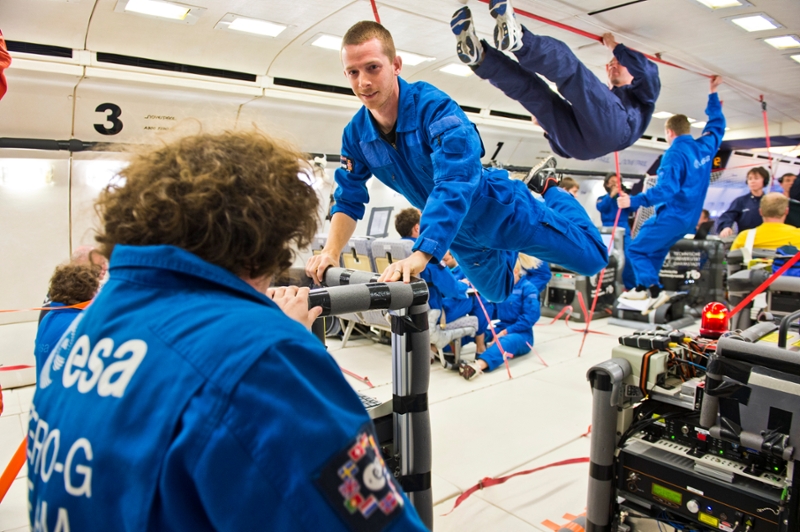Unlocking the secrets of the universe -- with lasers
Author: UNB Research
Posted on Aug 11, 2021
Category: Research

Photo: European Space Agency.
UNB researcher Dr. Brynle Barrett wants you to be able to know exactly where you are in the world – and answer some of the most fundamental questions of the universe while he does so.
Dr. Barrett is an atomic physicist and assistant professor whose research explores cold-atom-based systems that could provide alternatives to GPS, among many other uses. While working in the private sector developing technology for next-generation inertial navigation systems, Dr. Barrett’s team realized that cold atoms could open the door to new levels of precision in navigation.
“After 15 years of working in this field, you get an idea of the capability of these sensors and for what is lacking in the technology. So, the main drive of my future research will be to expand upon what is currently possible with these sensors and to help realize their full potential.”
Using a specialized system of lasers, these quantum sensors can measure incredibly small changes in forces such as gravity. This enables one to detect the presence of massive objects or voids underground, or to calculate the position of a moving vehicle with a high degree of accuracy.
There’s cool science, and then there’s cold science.
The groundbreaking science and innovation potential of Dr. Barrett’s research helped him secure $150,000 in funding from the Canada Foundation (CFI) for Innovation’s John R. Evans Leaders Fund (JELF). Dr. Barrett has also received $150,000 from UNB in support of this project and was previously awarded $177,500 from the Natural Science and Engineered Council of Canada and $50,000 from the New Brunswick Innovation Foundation.
This funding will help establish the Quantum Sensing and Ultra-cold Matter lab (QSUM), a new laboratory for the development of novel types of quantum sensors. There, Dr. Barrett is looking to build a unique group in Canada to investigate, and eventually commercialize, this quantum technology.
“The idea behind building quantum sensors out of ultra-cold matter is that, at extremely low temperatures, atoms begin to behave like waves.” Ultimately, it is the interference between these so-called matter waves that gives us precise measurements of different physical forces, like the acceleration due to gravity or magnetic fields.
Dr. Barrett’s lab will use different types of lasers to first cool atoms down to near-Absolute Zero (-273 degrees Celsius), and then interact with them in precise ways.
Although this research does not require infrastructure at the scale of the Large Hadron Collider or other high-energy physics institutes, the need for a custom-built system makes it expensive compared to other “table-top physics” experiments. “You need a lot of capital to build a lab like this, so that’s why getting this JELF is significant,” Dr. Barrett said, noting that one high-powered laser is almost $200,000, and the lab’s anticipated budget is filled with these.
Dr. Barrett hopes to create a quantum sensor that is more versatile than current ones, and more accurate than those based on classical (that is, non-quantum) technologies. Currently, atom-based systems are underutilized because they only measure along one particular axis. On the other hand, a triad of classical sensors can provide 3D measurements, but cannot approach the level of sensitivity that these new, state-of-the-art sensors can.
Bringing industry and academic knowledge together, with a view to the future:
Dr. Barrett explains that with a multifunctional quantum sensor, measuring several different effects at the same time, such as acceleration and rotation, is possible. This innovation opens up the use of these systems for navigation, timing, geophysical sensing and surveillance. With those possibilities in mind, as well as his extensive private sector experience, he is considering the questions of what industries might be interested in this technology, and what level of sensitivity would be required for different applications.
While this quantum technology exists largely as laboratory prototypes at this stage, it has strong potential to be a breakthrough for next-generation high-tech industries.
Dr. Barrett is also interested in this new field’s possibilities for research in fundamental physics.
“This science also allows us to probe fundamental physical theories with extreme accuracy,” Dr. Barrett said, referring to recent state-of-the-art tests of General Relativity and Quantum Electrodynamics which govern the forces due to gravity and the interaction between light and matter, respectively.
More information
Dr. Brynle Barrett (orcid) | Department of Physics | Faculty of Science
Research at UNB | Graduate Studies at UNB | Postdoctoral fellowships
Related Pages: UNB researchers supported by federal, provincial funding to better understand the natural environment and quantum physics